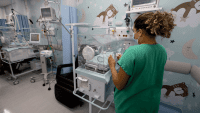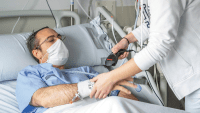To attain Magnet® recognition, an organization must have systematic peer-review practices.
To attain Magnet® recognition, an organization must establish formalized, systematic peer-review nursing practices to evaluate nursing care and nursing-care providers, as evident in the
Exemplary Professional Practice Component of the Magnet model. According to the American Nurses Credentialing Center, “The peer review process stimulates professionalism through increased accountability and promotes self-regulation of the practice.”
More than 20 years have passed since the American Nurses Association (ANA) published Peer Review Guidelines in 1988. This article defines and describes a set of principled peer-review guidelines for nurses based on ANA standards.
Peer review: A tool for career growth
Effective peer reviews in 3 easy steps
Defining peer review
The primary purpose of peer review is to help ensure the quality of nursing care through safe deliverance of standards of care and newly discovered evidence-based practices. The first definition of nursing peer review proposed by ANA in 1988 still applies today: “Peer review in nursing is the process by which practicing registered nurses systematically access, monitor, and make judgments about the quality of nursing care provided by peers as measured against professional standards of practice….Peer review implies that the nursing care delivered by a group of nurses or an individual nurse is evaluated by individuals of the same rank or standing according to established standards of practice.”
Both Peer Review Guidelines and the ANA Code of Ethics for Nurses (2001) focus on maintaining standards of nursing practice and upgrading nursing care in three contemporary focus areas for peer review—quality and safety, role actualization, and practice advancement.
Peer-review practice principles
Using the six peer-review practice principles below (which are based on the ANA Guidelines) helps ensure a consistent, evidence-based approach to peer review.
- A peer is someone of the same rank.
- Peer review is practice-focused.
- Feedback is timely, routine, and a continuous expectation.
- Peer review fosters a continuous learning culture of patient safety and best practice.
- Feedback is not anonymous.
- Feedback incorporates the nurse’s developmental stage.
Principle #1:
A peer is someone of the same rank.
Establishing clear boundaries and definitions for peer groups is essential for creating effective peer-review processes. Managers aren’t peers with direct-care nurses, even though managers have practiced as direct-care nurses. Peer groups include direct-care nurse to direct-care nurse, advanced practice nurse (APN) to APN, educator to educator, manager to manager, director to director, and nursing administrator to nursing administrator.
Principle #2:
Peer review is practice-focused.
Peer review provides a mechanism to ensure that new nursing standards of care are addressed. Effective peer review incorporates evidence-based nursing practice and quality and safety standards, with a focus on outcomes.
Principle #3:
Feedback is timely, routine, and a continuous expectation.
To continually ensure quality outcomes, peer review must be timely, continuous, and a routine expectation. To achieve continuous quality outcomes, organizations must create structures and processes that support dynamic feedback loops at all levels, starting at the point of care. Nurses also need new peer-review processes that move beyond traditional static processes (such as audits) to continuous and “just-in-time” models.
Principle #4:
Peer review fosters a continuous learning culture of patient safety and best practice.
Peer review done in the framework of a learning organization and a just culture helps nurses feel safe. A continuous learning culture shifts the focus from individual learning to organizational learning and fosters a common commitment to achieving and sustaining desired quality and safety outcomes. Direct-care nurses in a continuous learning culture frequently question the effectiveness of nursing practice. As a result, more timely modifications can be made to advance and update practice, along with the unlearning of ineffective or unsafe processes. Timely and continuous peer review provides the means for an effective systems-centered approach to error reduction.
Principle #5:
Feedback is not anonymous.
Positive nurse relationships emerge from focused, skillful dialogue. According to the ANA Code of Ethics, the nurse has a duty to use respectful communication with an open exchange of views to preserve practice integrity and safety. Anonymous feedback lacks empirical support in promoting professional growth and patient safety.
Principle #6:
Feedback incorporates the nurse’s developmental stage.
Decades of nursing research show that nursing practice develops along a novice-to-expert continuum. Participating in peer review can promote professional growth when the nurse’s developmental level is considered.
Putting peer review into action
Targeting peer-review activities at the point of care encourages staff to take an active role in monitoring and improving unit-based quality and safety outcomes. Using a shared governance framework with staff-nurse leadership promotes ownership and accountability for outcomes within the peer group and can yield creative solutions to long-standing issues. The following example illustrates the design and implementation of a point-of-care peer-review process to address a familiar quality challenge, using the principles described above.
Pressure-ulcer prevention
In many hospitals, the organizational nursing quality council analyzes trends and reports organizational and unit-based quality and safety nursing outcome performance measures every quarter. When improvement is needed on a unit-specific outcome, the unit-based nursing quality council (UBNQC) reviews, communicates, and takes action.
On one medical-surgical unit, the UBNQC noted that the unit’s pressure-ulcer prevalence had risen above national benchmarks. After examining the current pressure-ulcer prevention nursing care protocol and related education and competency assessment verification, the UBNQC concluded the protocol was up-to-date and related staff education and competency assessment had been completed. But a subsequent chart audit by the UBNQC found inconsistencies in documentation on the protocol intervention record, which is based on the Braden scale. Council members found that the relationship between the Braden scale score and determination of a patient’s pressure-ulcer risk wasn’t always clear; thus, the protocol wasn’t always individualized to the patient. Also, some nurses were still using nonapproved interventions, such as donut rings and massage.
So the UBNQC designed a peer-review process to monitor use of the protocol and patient-specific interventions. Before implementation, staff education was provided on the protocol, related nursing-care expectations, and the peer-review process. Expectations included a face-to-face handoff at the bedside; use of the pressure-ulcer prevention monitoring sheet; and correction of care deficiencies, alterations from the protocol, or unimplemented interventions found during handoff. The peer-review process was designed to occur daily for 30 days. The tool was returned to the UBNQC for peer review—not to the manager, supervisor, clinical nurse specialist, or educator.
Weekly reviews of data sheets by a UBNQC representative helped identify emerging issues that might need closer surveillance or intervention before the monitoring period ends. All council members reviewed results from the monitoring period at their monthly meeting to identify trends and issues that needed additional attention and to decide if shift-to-shift monitoring should continue. Overall effectiveness of this focused peer review was reflected in periodic reports from the wound-care team rounds and quarterly pressure-ulcer prevalence data.
This unit-based peer-review practice incorporated established peer-review principles in these ways:
- A peer is someone of the same rank. Direct-care nurses created and monitored the process using shared governance processes—a real-time peer-to-peer practice review.
- Peer review is practice-focused. Criteria focused on national evidence-based nursing standards.
- Feedback is timely, routine, and a continuous expectation. All direct-care nurses were expected to participate in assuring adherence to the pressure-ulcer prevention protocol during each scheduled handoff. Nurses were jointly responsible for identifying and correcting deviations from the protocol and completing the monitoring sheet during face-to-face interactions.
- Peer review fosters a continuous learning culture of patient safety and best practice. This project involved collaboration between two nursing councils, focusing on evidence-based practice and quality data in creating a monitoring process and tool and subsequent education on the protocol. Frequent discussions of the protocol during handoffs provided opportunities for continuous learning and engagement on pressure-ulcer prevention.
- Feedback is not anonymous. Peer-to-peer feedback was done face-to-face at the time of handoffs and gave nurses a chance to give and receive feedback.
- Feedback incorporates the nurse’s developmental stage. Face-to-face handoffs gave less experienced nurses the chance to interact with and be mentored by experienced nurses and gain knowledge and insight into pressure-ulcer prevention.
Peer review promotes the highest standards
ANA’s Code of Ethics recognizes that effective peer review is indispensable for holding nursing practice to the highest standards. Peer review helps address the boundaries of duty and loyalty for all nurses, including “the responsibility to preserve integrity and safety, to maintain competence, and to continue personal and professional growth.”
Selected references
American Nurses Association (ANA). Peer Review Guidelines. Kansas City, MO: ANA; 1988.
American Nurses Credentialing Center (ANCC). The Magnet Model Components and Sources of Evidence. Silver Spring, MD: ANCC; 2009.
Bergstrom N, Braden BJ, Kemp M, Champagne M, Ruby E. Reliability and validity of the Braden Scale: a multi-site study. Nurs Res. 1998;47(5):261-269.
Catania K, Huang C, James P, Madison M, Moran M, Orh M. PUPPI: the pressure ulcer prevention protocol. AJN. 2007;107(4):44-52.
George V, Haag-Heitman B. Nursing peer review: the manager’s role. J Nurs Manag. 2011 Mar;19(2):254-9. doi: 10.1111/j.1365-2834.2011.01225.x.
Grady D. Study finds no progress in safety at hospitals. New York Times. November 24, 2010. http://www.nytimes.com/2010/11/25/health/research/25patient.html. Accessed August 4, 2011.
Haag-Heitman B, George V. Guide for Establishing Shared Governance: A Starter’s Toolkit. Silver Spring, MD: American Nurses Credentialing Center; 2010.
Haag-Heitman B, George V. Peer Review in Nursing: Principles for Successful Practice. Sudbury, MA: Jones & Bartlett; 2011.
Institute of Medicine. The Future of Nursing: Leading Change, Advancing Health. Washington, DC: National Academies Press; 2010.
Landrigan C, Parry G, Bones C, Hackbarth A, Goldman D, Sharek P. Temporal trends in rates of patient harm resulting from medical care. N Engl J Med. 2010;363(22):2124-2134.
Rothschild JM. Hurley AC, Landrigan CP, et al. Recovery from medical errors: the critical care nursing safety net. Jt Comm J Qual Patient Saf. 2006;32(2);63-72.
****Visit www.AmericanNurseToday.com/Archives.aspx for a table delineating the six contemporary peer-review principles.***
Barb Haag-Heitman is an independent healthcare consultant and president of Barb Haag-Heitman and Associates Healthcare Consulting in Whitefish Bay, Wisconsin. Vicki George is president and chief executive officer of VMG Consulting in Plainfield, New Hampshire.


















3 Comments.
This is the best, clearest explanation of the peer review process. Thank you for publishing.
how do you score the case that are presented in NPR
This document was so helpful. Thank you all for establishing this site…..